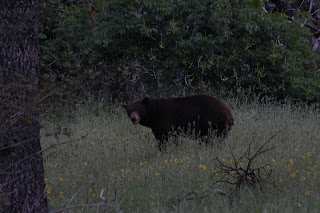My wife is trilingual. As an Ecuadorian, her first language is Spanish but she speaks fluent English and German. This does not mean she always understands me or the odd American idioms I spout out. I once attempted to calm her frustrations by suggesting she not get “bent out of shape”. She heard “banana shake” and the conversation thankfully turned to desserts. After a close encounter with a Black Bear in Yosemite National Park
I’m not a coward, although as a child I did react to a fire alarm in our house by fleeing and yelling for someone to save my sister. Labels can be hard to take and tough to shake. Yosemite Sam indoctrinated a legion of Loony Tunes fans to believe that a Yellow-bellied Marmot (Marmota flaviventris) or varmint is a coward. Having never seen one I assumed this to be true. I also believed that all gunpowder trails lead to a shed full of TNT.
I spotted my first Yellow-bellied Marmot on a walk in the woods in Sequoia National Park
Although marmots are cousins to the eastern Woodchuck (Marmota monax), they are social and live in colonies. One individual often gets sentinel duty and watches for danger while the others forage. The shrill this “whistle pig” was producing apparently had the effect of an alarm and sent the other marmots into their underground burrow, which in some colonies can contain over 200 feet of passages.
In the high Sierras of California, marmots hibernate from September to May but if this Yellow-bellied individual was shaking off its eight month slumber you could never tell. It had all the energy and excitability of Yosemite Sam with a stick of dynamite in his pants. It was endearing to watch this individual protecting the colony. It’s time to rethink the “yellow-belly” label and I guess I better go save my sister.






